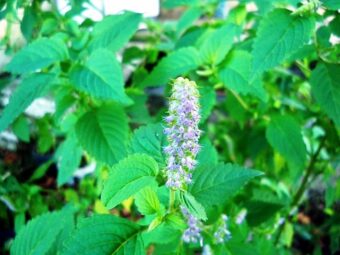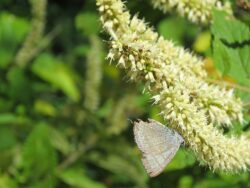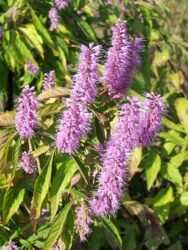In this article, we will discover how to grow the beautiful shrub of Elsholtzia in containers. Elsholtzia is a fairly large genus of the Lamiaceae (Mint) family, where 42 species are known to exist. It is native to parts of Asia, China and North-eastern Asia. The genus was named after the Prussian naturalist Johann Sigismund Elsholtz.

Of all 42 species that exist, Elsholtzia stauntonii is the easiest to find and is an upright bush that grows up to 1.5m tall. It is a deciduous shrub with sharply to smoothed, 1.5cm long, lance-shaped leaves. The leaves have a strong scent of mint, especially when they are crushed. The dark green leaves will turn yellow, orange and red in autumn.
In late summer to early autumn, 20cm high panicles of flowers appear on top of the stem. They appear upright and have numerous pink or purplish flowers all along the top of the stem. The flowers if they appear in August can last well onto autumn. This will give a valuable long-lasting splash of colour late in the season.
Find out how to grow the shrub in containers in this article.
GROWING ELSHOLTZIA IN CONTAINERS
First, you will need to choose a container that is big enough to hold the plant in question and is also well-proportioned. No matter what you choose make sure it has plenty of drainage holes at the bottom.
On top of this add a 2cm layer of gravel to aid drainage further. At planting, you will need to create a rich growing media by mixing 80% by volume of multipurpose compost with 20% by volume of well-rotted manure. To this add a couple handfuls of growmore or fish, blood and bone and fill the container to within 5cm below the rim of the container.
Dig a hole at the centre of the container slightly bigger than the root ball it came in the original container. Drop the plant in so that the top of the root ball is at the same level as the top surface of the compost. Backfill with the growing media so that no gaps remain, using more compost if necessary. Firm the plant in and water well.
BEST GROWING CONDITIONS
It is best to place your plant in a sheltered location in full sun. Full sun is essential, otherwise, the shrub will not do well. Frequent watering will be required until it is well-established. You will need to water when 5cm below the top surface of the compost feels dry to the touch. This will mean frequently watering when it is dry and hot.
You will need to feed every spring with a general-purpose slow-release fertilizer to give it a boost throughout the growing season. You can give a two-weekly feed with high potash fertilizer once flowering has begun to give an extra special display.

Pruning is quite simple, you will need to cut back all old stems to ground level in late winter or early spring.
To propagate you can plant softwood or semi-ripe cuttings in a cold frame in summer.
PESTS AND DISEASES
The great news is that Elsholtzia does not suffer from any pests and diseases, so it is well worth growing for those who have had problems in the past.
VARIETIES TO GROW
As mentioned in the introduction the species to grow and is easy to find is Elsholtzia stauntonii. This is described in great detail in the introduction and so will not be repeated here. A rare variety to find is ‘Alba’ which produces white flowers.
Another alternative is Elsholtzia fruticosa which is slightly taller, growing up to 2m high.
CONCLUSIONS
In this article, we have discussed how to grow the late flowering but not-so-often seen shrub of Elsholtzia in containers. They are a member of the mint flower but instead are grown for the flowers that they produce. They are easy to care for, easy to grow and do not suffer from pests and diseases. If you add the ease to prune and propagate then you will understand the potential of this flowering shrub.
If you have any questions or comments that you wish to make on growing Elsholtzia in containers, please do so in the comment box below.
Happy Elsholtzia growing.


I have just purchased elsholtzia stauntonii but I’m unsure if I planted in the garden whether it would become invasive like common garden mint? Would it be better in a pot? I have 3 in total grown in 9cm pots. Should I plant all 3 together to give a spectacular display of flowers? Your information made good reading.
Hi Carol
Like plants in the mint family it can become invasive but it is not as invasive as garden mint. I would grow in a pot but only one specimen per pot as they are big shrubs, You can plant them in groups, one per pot to give more impactful display.
Thanks
Antonio